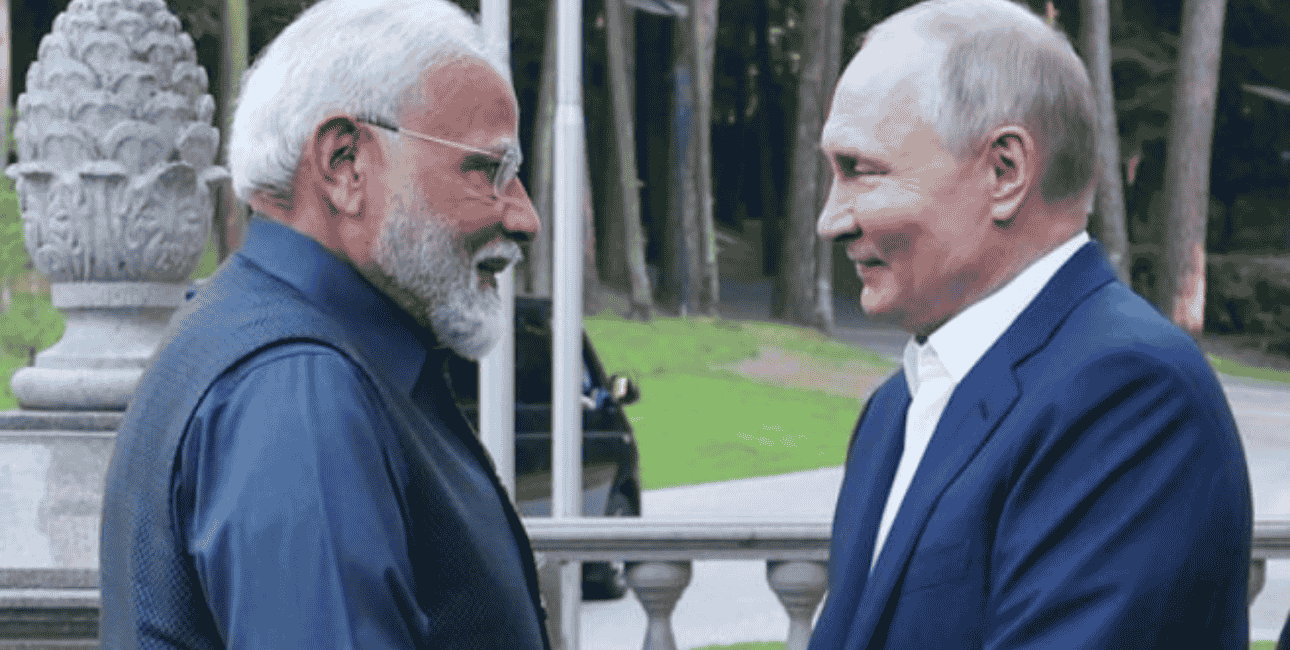India’s Ministry of External Affairs has strongly refuted a New York Times story alleging that India’s state-owned Hindustan Aeronautics Limited (HAL) may have “re-routed British sensitive equipment” to Russia that ultimately helped Moscow sustain its war effort against Ukraine.
India’s foreign ministry sources called the report “factually incorrect and misleading,” stating that it misrepresented facts and framed issues to suit a particular political narrative.
“We (Ministry of External Affairs) have seen a report published by The New York Times. The said report is factually incorrect and misleading. It has tried to frame issues and distort facts to suit a political narrative. The Indian entity (Hindustan Aeronautics Limited-HAL) mentioned in the report has scrupulously followed all its international obligations on strategic trade controls and end-user commitments,” MEA sources told news agency ANI.
The ministry further highlighted India’s strong legal and regulatory framework for strategic and sensitive trade, asserting that all Indian companies have to follow these regulations.
“India’s robust legal and regulatory framework on strategic trade continues to guide overseas commercial ventures by its companies. We expect reputed media outlets to undertake basic due diligence while publishing such reports, which obviously was overlooked in the instant case,” sources added.
What The NYT Story Claimed
On March 28, the New York Times reported that HAL bought USD2 million worth of transmitters, cockpit equipment, antennas, and other sensitive technology from a British aerospace firm, HR Smith Group, between 2023 and 2024 and later transferred similar equipment to Russia’s state-owned arms agency, Rosoboronexport.

The report alleged that Techtest, which is owned by the H.R. Smith Group, made 118 shipments of restricted technology to Hindustan Aeronautics in 2023 and 2024. These components have dual civilian and military usage.
During that period, “the Indian firm made at least 13 shipments of the same type of parts to a buyer for Rosoboronexport, which is blacklisted by the British and American authorities.”
According to the records reviewed by the NYT, the Russian arms agency paid more than US$14 million for the equipment. If the allegations made in the report are true, then HAL sold these dual-use components to Russia at seven times the price they paid the British firm, thus making substantial gains.
The report claims: “On Sept 2, 2023, Techtest sold Hindustan Aeronautics two shipments of restricted equipment, including location transmitters and remote controllers. Nineteen days later, the Indian company sold parts to Russia with matching identification codes.”
However, it must be noted that the NYT report itself acknowledges that there was no direct proof that HR Smith’s products reached Russia. Instead, it pointed to shipment records with matching product identification codes as evidence.
Not The First Time India Has Been Blamed
While Indian government sources have rejected the report, it must be noted that this is not the first time that such allegations have been made against India since the Russia-Ukraine war started in 2022.
Western media reports have periodically accused India of acting as a middleman by supplying critical components to Russia, allegedly helping Moscow evade Western sanctions imposed due to the Ukraine conflict.
These reports have cited India’s export of electronics, machinery, and other high-tech components to Russia, suggesting these could support Russia’s military-industrial complex.
In November 2022, Reuters reported that Russia requested over 500 products, including cars, aircraft, and train parts, from India as Western sanctions disrupted its supply chains. The report, titled “India asked by sanctions-hit Russia for parts for key sectors,” cited unnamed sources and a 14-page list reviewed by Reuters, noting Indian firms’ hesitancy due to fears of Western backlash.
In February 2024, a CNN report titled “India’s increased purchase of Russian oil is helping fuel Ukraine war” focused on India’s US $37 billion oil trade with Russia, implying that India’s broader trade, including potential re-exports of refined products or components, undermines sanctions.
Further, in September 2024, a Financial Times report claimed that leaked Russian documents revealed a US$1 billion plan by Russia’s Industry and Trade Ministry to acquire critical electronics via India, using rupee reserves from oil sales.
The FT report, “Russia Secretly Buying Sensitive Electronics From India,” even named an Indian firm, Innovio Ventures, as supplying Russia with US$4.9 million in electronics equipment, including drones.
In October 2024, Bloomberg reported that the US State Department has imposed sanctions on about 400 entities and individuals, including 19 Indian firms and two Indian nationals, for helping Russia’s war efforts in Ukraine.
The report named Indian firms like Ascend Aviation India Private Limited, Mask Trans, Futrevo, and TSMD Global Private Limited, which were placed under sanctions for supplying sensitive dual-use components to Russia.
However, it must be noted that the US State Department had sanctioned nearly 400 companies spread across 17 jurisdictions, including China, Turkey, Switzerland, and the UAE.
Another Bloomberg report – “India Is Now Russia’s No. 2 Supplier of Restricted Technology,” claimed that “Indian exports of restricted items such as microchips, circuits, and machine tools surpassed US$60 million in both April and May, about double from earlier months this year, and leaped to US$95 million in July 2024.”
Hard Evidence Or Hit Jobs By Western Media
The reports cited above clearly show that during the last two years, multiple Western media outlets have repeatedly and consistently blamed India for undermining Western sanctions on Russia and helping Moscow’s war effort against Ukraine by supplying it with dual-use components and technologies.
So, the question arises: are these multiple reports citing ‘hard, irrefutable evidence’ or are they built on conjectures and circumstantial evidence that can be interpreted in multiple ways to suit one’s political agenda?
There are, actually, certain common themes in all these media reports.
Unnamed Sources: Most of these reports cite subject matter experts, foreign trade experts, government sources, intelligence sources, and aerospace and engineering experts. However, what is common among all these reports is that all these sources and so-called experts are unnamed.
For instance, the Bloomberg report from October 2024, alleging that India had become Russia’s second-biggest supplier of restricted critical technologies, cited information based on quotes provided by US and European officials, but it did not name any of the officials.
These unnamed sources could be anyone. They could have hidden agendas to advance a particular narrative in the media. They could be elements of the deep state that want to build pressure on India to take a more hard-line position on Russia.
Evidence Gaps: Many reports rely on trade surges, leaked plans, or sanctions lists rather than concrete proof of military end-use. Dual-use goods, which have civilian applications, complicate attribution.
For instance, the Bloomberg report from October 2024 was based on export surges from India. However, it did not specify whether these export surges were going to Russia. Further, almost all electronic products today, from washing machines to geysers, have microchips in them.
These same microchips could be used in drones that are used in Russia’s war against Ukraine. So, by that logic, the export of any electronic consumer goods from India to Russia could be flagged as helping Russia avoid Western Sanctions and aiding Moscow’s war effort against Kyiv.
Similarly, the recent NYT report acknowledges that there was no direct proof that HR Smith’s products reached Russia with the connivance of HAL. Instead, it pointed to shipment records with matching product identification codes as evidence.
This is ‘circumstantial evidence’ at best and not conclusive proof of India acting as a backdoor entry for supplying Russia with military equipment after buying it from Western sources.
Conclusion
The NYT report is not the first, nor will it be the last, to blame India or Indian firms for helping Russia avoid Western sanctions and aiding Moscow’s war effort in Ukraine.
However, as explained above, these reports are based on unnamed sources, leaked reports, trade surges between India and Russia, and legal trade in oil products. Many times, the reports are based on trade surges in dual-use products, having both civilian and military applications.
Even when there is absolutely no evidence of Indian exports being used in Russian military equipment, the mere trade surge in consumer electronic goods between India and Russia is often enough for these media outlets to flag as possible violations of Western sanctions on Russia.
Indeed, Indian and Russian trade has surged since the war began.
Bilateral trade between India and Russia reached a record high of USD 65.7 billion in FY 2023-24, up 33% year over year and nearly 5.5 times higher than the pre-pandemic trade of USD 10.1 billion.
But this is because India stepped up its purchase of discounted Russian oil after Western European countries stopped buying it. India’s buying vast quantities of Russian oil has resulted in a huge trade surplus in Russia’s favor.
Since India does not want to pay for this trade deficit in dollars, it encouraged Moscow to conduct business in rupees and rubles. However, since Russia was buying very little from India in exchange for its oil, it resulted in Indian rupees getting accumulated in Russian banks.
Thus, New Delhi encouraged Russia to buy more electronics and consumer goods from India to offset the accumulation of Indian rupees in Russian banks. Earlier, Russia was largely dependent on Europe and China for consumer goods. Now, having been cut off from European consumer goods, Moscow has invested in joint ventures in India to manufacture consumer goods for the Russian market.
Even when fully legal, this trade in consumer goods and electronics could be flagged as a potential violation of sanctions, as these electronic goods often carry microchips that could also be used in military drones.
Thus, in the lack of any conclusive proof or direct evidence of India supplying goods sourced from Western countries to the Russian military, it is difficult to ascertain whether these reports in Western media are credible or indeed hit jobs to pressurize India to abandon its neutral stance in the Ukraine war.
- Sumit Ahlawat has over a decade of experience in news media. He has worked with Press Trust of India, Times Now, Zee News, Economic Times, and Microsoft News. He holds a Master’s Degree in International Media and Modern History from The University of Sheffield, UK.
- VIEWS PERSONAL OF THE AUTHOR
- He can be reached at ahlawat.sumit85 (at) gmail.com




